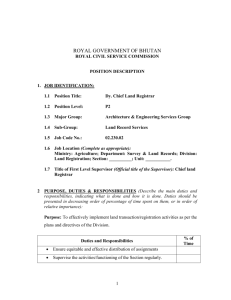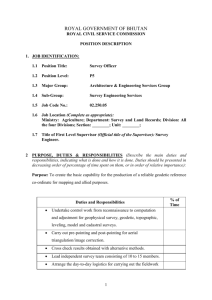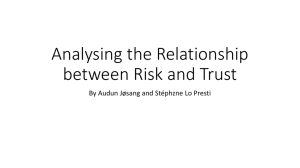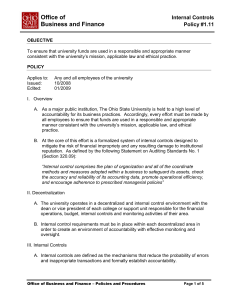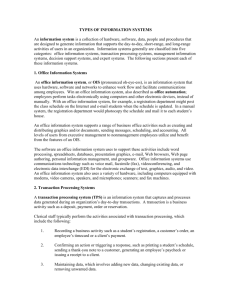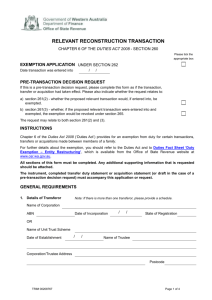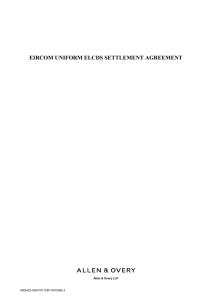Chief Land Registrar
advertisement
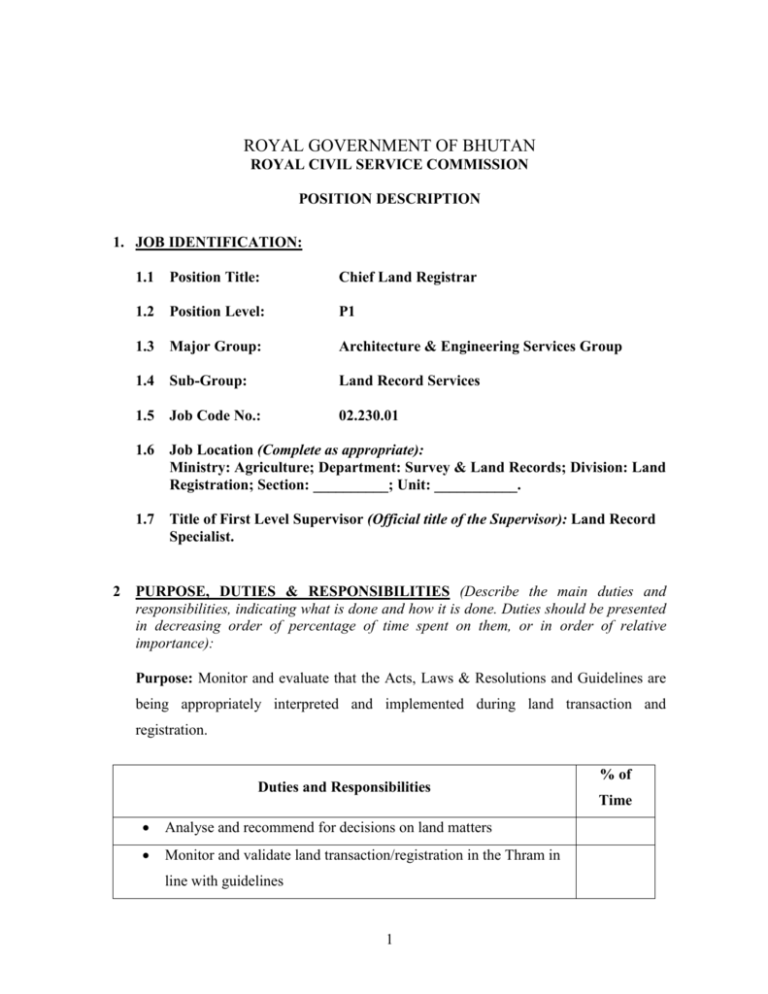
ROYAL GOVERNMENT OF BHUTAN ROYAL CIVIL SERVICE COMMISSION POSITION DESCRIPTION 1. JOB IDENTIFICATION: 1.1 Position Title: Chief Land Registrar 1.2 Position Level: P1 1.3 Major Group: Architecture & Engineering Services Group 1.4 Sub-Group: Land Record Services 1.5 Job Code No.: 02.230.01 1.6 Job Location (Complete as appropriate): Ministry: Agriculture; Department: Survey & Land Records; Division: Land Registration; Section: __________; Unit: ___________. 1.7 Title of First Level Supervisor (Official title of the Supervisor): Land Record Specialist. 2 PURPOSE, DUTIES & RESPONSIBILITIES (Describe the main duties and responsibilities, indicating what is done and how it is done. Duties should be presented in decreasing order of percentage of time spent on them, or in order of relative importance): Purpose: Monitor and evaluate that the Acts, Laws & Resolutions and Guidelines are being appropriately interpreted and implemented during land transaction and registration. Duties and Responsibilities Analyse and recommend for decisions on land matters Monitor and validate land transaction/registration in the Thram in line with guidelines 1 % of Time Plan strategies for verification of land disputes/discrepancies. Review budget requirement Evaluate the intent for any change of transaction and registration system in the Kingdom Formulate guidelines for maintenance of records about ownership, types, classification, acreage of land, etc. Standardise land transaction and registration procedures Interact closely with Dzongkhags and other concerned authorities on land transaction and registration matters Represent the Department in DYT on land related issues Supervise subordinates Any others 3 KNOWLEDGE AND SKILLS REQUIREMENTS (Minimum requirement for performance of work described – Level of Knowledge, Skill and Ability): 3.1 Education: Bachelors 3.2 Training: Advance training in land Administration and Management or land Valuation or land Legislation or Land Information System 3.3 Length and type of practical experience required: Minimum of four years as Deputy Chief Land Registrar or equivalent experience. 3.4 Knowledge of language(s) and other specialized requirements: Good command over written and spoken Dzongkha and English. Other dialects of the country would be an added advantage. Knowledge in cadastral mapping aspects. Good public relations. 2 4 COMPLEXITY OF WORK (The nature, number and intricacy of tasks, steps, processes or methods involved in work; difficulty and originality involved in work): Ensure that all Acts/Resolutions passed are strictly adhered to and applied appropriately to the varied land related cases. Require intricate balancing between the capability and the requirement of deep understanding of the subject matter and proficiency to analyse the matter in relation to available rules and regulations. Determine any contentious issue in this position requires broad functions to be performed concurrently to the utmost capacity and understanding of the societal ethos. 5 SCOPE AND EFFECT OF WORK (Describe the purpose, breadth of work performance, and the effect the work has on the work of others or the functions of the organization): Involve careful planning, developing and carrying out professional programmes and administrative functions. Essential in determining the achievements of the Division to assess the concurrent progress of the work. Have a great impact on the mission of the Division, as they affect a considerable number of people on a continuing basis, as the Division deals with transaction and registration of land holdings. 6 INSTRUCTIONS AND GUIDELINES AVAILABLE 6.1 Instructions: (Describe controls exercised over the work by the superior; how work is assigned, reviewed and evaluated): Supervisor makes assignments in terms of broadly defined missions or functions. Completed work is accepted, as legally/technically authoritative, usually without change and considers being within the framework of the rules. Though guidelines 3 are broadly stated, they are non-specific and require extensive interpretation of intent and applying to those issues, which are not expressive and specific. 6.2 Guidelines: (Indicate which written or unwritten guidelines are available, and the extent to which the employees may interpret, adapt or devise new guidelines): Among others, the following are the main available guidelines - Thrimzhung Chenmo, Land Act 1979, Inheritance Act 1980, Forest and Nature Conservation Act 1995, Forest Rules & Regulations, Movable & Immovable Property Act 1999, Company Act 2000, Royal Decrees, National Assembly Resolutions, Government circulars/directives, Land Compensation Rate 1996, Road Act 2004, Guidelines on Land Registration & Transaction and New Sathram Compilation, Surveying and Mapping guidelines and many other host of relevant laws, Land Information Systems (LIS). The functions are to be discharged within this purview strictly. 7 WORK RELATIONSHIP (Indicate the frequency, nature and purpose of contacts with others within and outside the assigned organization other than contacts with superiors): Personal contacts are with officials within and outside the employing agency. The frequency of such contacts, particularly with the public and government officials is high as the Division deals with transaction/registration of land holdings. The purpose of such contact is to explain, clarify, justify and settle matters involving controversial issues. 8 SUPERVISION OVER OTHERS (Describe responsibility for supervision of other employees, including the nature of supervisory responsibilities and classification and number of subordinates): Provide administrative and general direction to 20-30 Dy. Chief Land Registrars. Give specific direction to the performance of responsibilities in respect of land disputes and preparation of reports and correspondences. 4 Involve a great deal of legal and technical issues to be processed in line with Land Act, Guidelines, National Assembly Resolutions, etc. 9. JOB ENVIRONMENT (Describe physical exertion required, such as walking, standing, lifting heavy objects, etc., and/or any risks or discomforts like exposure to hazards such as exposure to chemicals, infections, radiation, extreme weather and other hostile working conditions): The work environment demands no physical work performance other than occasional walking during field inspection/verification. The work environment involves no risks or discomforts of everyday circumstances. 5
